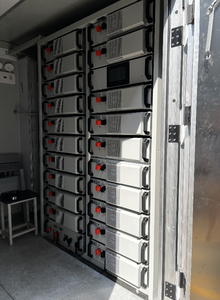Phổ biến trong ngành của bạn






Hệ Thống Lai Năng Lượng Mặt Trời Kit 5Kw 10Kw 12Kw 15Kw 18Kw 20Kw 25Kw 30Kw Off Grid Năng Lượng Mặt Trời Hệ Thống Năng Lượng Lưu Trữ Trang Chủ Thương Mại
899,00 US$ - 2.250,00 US$
Đơn hàng tối thiểu: 1 Bộ







Hệ Thống Năng Lượng Mặt Trời Off Grid 5KW 10KW 20KW 25KW 30KW Năng Lượng Mặt Trời Hệ Thống Điện Thương Mại Công Nghiệp Trang Chủ Để Bán
899,00 US$ - 2.218,00 US$
Đơn hàng tối thiểu: 1 Bộ







New Arrival 5KW 10KW 15KW 20KW 25KW 30KW Năng Lượng Mặt Trời Hệ Thống Bảng Điều Khiển Cho Nhà 220V Năng Lượng Mặt Trời Hệ Thống Lưu Trữ Bộ Dụng Cụ Trang Trại
899,00 US$ - 2.250,00 US$
Đơn hàng tối thiểu: 1 Bộ







Hệ thống năng lượng mặt trời tắt lưới 5KW 10KW 20kW 25kw 30Kw hệ thống năng lượng mặt trời nhà công nghiệp thương mại để bán
899,00 US$ - 2.240,00 US$
Đơn hàng tối thiểu: 1 Bộ







Wtl năng lượng mặt trời Máy phát điện 300W 500W 1000W 1500W 2000W 3000W 5000W 10000W UPS pin ngoài trời Trạm điện cầm tay với tấm pin mặt trời

49,00 US$ - 1.582,00 US$
Đơn hàng tối thiểu: 1 Cái







Hệ Thống Nhà Máy Điện Tấm Năng Lượng Mặt Trời Kết Hợp Thiết Kế Hoàn Chỉnh 500kw Máy Phát Điện 5kw Điện 10 Mw
300.000,00 US$ - 500.000,00 US$
Đơn hàng tối thiểu: 1 Bộ






Containerized xếp chồng lên nhau 10 megawatt năng lượng mặt trời nhà máy pin điện container năng lượng Hệ thống lưu trữ
0,35 US$ - 0,50 US$
Đơn hàng tối thiểu: 1000 Watt






500kw thiết kế hoàn chỉnh lai năng lượng mặt trời nhà Bảng điều khiển hệ thống nhà máy điện 5KW Máy phát điện điện 10 mW eolienne
260.000,00 US$ - 450.000,00 US$
Đơn hàng tối thiểu: 1 Bộ






Năng lượng mặt trời điện năng lượng mặt trời hệ thống tốt nhất năng lượng mặt trời nhà máy điện 1 mW 5mW 10mW trên lưới năng lượng mặt trời năng lượng cho vườn
0,32 US$ - 0,50 US$
Đơn hàng tối thiểu: 100 Kilowatt






Esg thay thế nhà máy Điện Gió Máy phát điện năng lượng 5KW tuabin gió giá năng lượng mặt trời hệ thống điện
2.400,00 US$ - 2.800,00 US$
Đơn hàng tối thiểu: 2 Bộ
Vận chuyển mỗi chiếc: 171,18 US$






Sunpal Containerized 10 Megawatt Nhà Máy Năng Lượng Mặt Trời Pin Điện Container Hệ Thống Lưu Trữ Năng Lượng
99.999,00 US$ - 120.000,00 US$
Đơn hàng tối thiểu: 1 Đơn vị






Thiết lập năng lượng mặt trời nhà máy điện lai năng lượng mặt trời hệ thống điện 30Kw 50kw 100kw năng lượng mặt trời nhà máy điện
0,18 US$ - 0,60 US$
Đơn hàng tối thiểu: 500000 Watt
Các tìm kiếm liên quan:
nhà máy điện năng lượng mặt trờinhà máy hệ thống năng lượng mặt trời 1mwhệ mặt trời thực vật500kw năng lượng mặt trời hệ thống năng lượng mặt trờihệ thống năng lượng mặt trờihệ thống nhà máy điện mặt trời 100kwnhà máy điện mặt trời mininhà máy điện mặt trời thương mạinhà máy mini năng lượng mặt trờinhà máy điện mặt trời tập trungnhà máy điện năng lượng mặt trời lainhà máy năng lượng mặt trời cho ngôi nhàhệ thống lưu trữ 100kw nhà máy năng lượng mặt trờinhà máy điện mặt trời 5mwlớn nhất năng lượng mặt trời nhà máy điện nhà cung cấp






Một cửa năng lượng mặt trời hệ thống 500kw ESS container dự án thương mại lai năng lượng mặt trời hệ thống điện lưới Tie năng lượng mặt trời nhà máy năng lượng lưu trữ
0,70 US$ - 1,00 US$
Đơn hàng tối thiểu: 500000 Watt






Đầy đủ soler năng lượng lưu trữ tấm pin lithium cho bộ hoàn chỉnh solor Off lưới điện nhà máy điện năng lượng mặt trời hệ thống
0,30 US$
Đơn hàng tối thiểu: 300 Watt
Vận chuyển mỗi chiếc: 251,67 US$






Esg thay thế nhà máy Điện Gió Máy phát điện năng lượng 5KW tuabin gió giá năng lượng mặt trời hệ thống điện
2.400,00 US$ - 2.800,00 US$
Đơn hàng tối thiểu: 2 Bộ
Vận chuyển mỗi chiếc: 142,65 US$






Esg thay thế nhà máy Điện Gió Máy phát điện năng lượng 5KW tuabin gió giá năng lượng mặt trời hệ thống điện
2.400,00 US$ - 2.800,00 US$
Đơn hàng tối thiểu: 2 Bộ
Vận chuyển mỗi chiếc: 194,44 US$






Containerized xếp chồng lên nhau 10 megawatt năng lượng mặt trời nhà máy pin điện container năng lượng Hệ thống lưu trữ
0,20 US$ - 0,39 US$
Đơn hàng tối thiểu: 1000 Watt






3KW 5KW 10KW 15KW 20kW 30Kw 120V 230V hoàn thành quang điện năng lượng mặt trời hệ thống 50kva Tấm Pin Mặt Trời Kit cho nhà
4.400,00 US$ - 4.900,00 US$
Đơn hàng tối thiểu: 1 Bộ
Vận chuyển mỗi chiếc: 1.070,70 US$






Hệ Thống Gắn Lưới Năng Lượng Mặt Trời Hệ Thống Nhà Máy Điện Năng Lượng Mặt Trời 1kw 10kw 100kw Tấm Năng Lượng Mặt Trời
0,98 US$ - 1,50 US$
Đơn hàng tối thiểu: 100 Watt






Hệ thống năng lượng mặt trời công nghiệp 50 kW Nhà máy năng lượng mặt trời 60kw 70kw trên hệ thống năng lượng mặt trời lưới
0,35 US$ - 0,55 US$
Đơn hàng tối thiểu: 100000 Watt
Vận chuyển mỗi chiếc: 29,98 US$






Tinh khiết sine 3000wh AC Ổ cắm điện nhà máy điện và năng lượng mặt trời hệ thống năng lượng cho cắm trại rving Caravan
1.410,00 US$ - 1.595,00 US$
Đơn hàng tối thiểu: 1 Cái






Rất Useful tắt lưới 2kw 2000 wát hệ thống nhà cung cấp 5.6kw - 8.5kw ngày nhà máy điện năng lượng cho gia đình điện năng
2.500,00 US$ - 2.600,00 US$
Đơn hàng tối thiểu: 1 Cái






Hệ Thống Năng Lượng Mặt Trời 3000W Máy Phát Điện Năng Lượng Mặt Trời/3KW Bộ Hoàn Chỉnh Hệ Thống Tấm Năng Lượng Mặt Trời Cho Biệt Thự
2.800,00 US$
Đơn hàng tối thiểu: 100 Watt






EU balkonkraftwerk 800W 600W có thể điều chỉnh góc ban công năng lượng mặt trời bảng điều khiển năng lượng hệ thống cắm và chơi năng lượng mặt trời vi Hệ thống biến tần

0,40 US$ - 0,60 US$
Đơn hàng tối thiểu: 800 Watt
Vận chuyển mỗi chiếc: 7,09 US$






Hộp Kết Hợp 20 Dây DC Với 1000V 40KA SPD Cho Hệ Thống Nhà Máy Điện Năng Lượng Mặt Trời
680,00 US$
Đơn hàng tối thiểu: 2 Cái












Công nghiệp 500kw 550kw 600kw 650kw 700kw năng lượng mặt trời Máy phát điện năng lượng mặt trời nhà máy trên lưới năng lượng mặt trời hệ thống với giá tốt nhất và chất lượng
0,16 US$ - 0,22 US$
Đơn hàng tối thiểu: 10000 Watt






Trạm năng lượng mặt trời di động 100W 600W 800W ban công bảng điều khiển năng lượng mặt trời hệ thống nhà máy điện hệ thống năng lượng mặt trời cho hệ thống lưu trữ năng lượng gia đình
155,00 US$ - 220,00 US$
Đơn hàng tối thiểu: 1 Bộ
Vận chuyển mỗi chiếc: 111,30 US$




SCU Có Thể Sạc Lại LiFePO4 Pin Tiết Kiệm Năng Lượng Hệ Thống Lưu Trữ Off Grid Giải Pháp Năng Lượng Hệ Thống Nhà Máy Năng Lượng Mặt Trời Tất Cả Trong Một
27.000,00 US$ - 28.000,00 US$
Đơn hàng tối thiểu: 1 Bộ






ESG Bộ Quang Điện Bộ PV Năng Lượng Mặt Trời Điện Lithium Gia Dụng Hệ Thống Điện Năng Lượng Mặt Trời Lưới Ngoài 10000W
5.000,00 US$ - 5.500,00 US$
Đơn hàng tối thiểu: 10 Bộ






Hệ thống năng lượng mặt trời công nghiệp 300kw 500kw 1mwh trên dự án LAI LƯỚI

0,50 US$ - 0,80 US$
Đơn hàng tối thiểu: 300 Kilowatt






Pin Lithium Ups Tích Hợp Hệ Thống Năng Lượng Dự Phòng Lai
0,80 US$ - 1,10 US$
Đơn hàng tối thiểu: 30000 Watt






Trạm Năng Lượng Mặt Trời Hệ Thống Tấm Năng Lượng Mặt Trời 800KW Sử Dụng Thương Mại 500KW 600KW 1MW 2MW Nhà Máy Điện Năng Lượng Mặt Trời
177,55 US$ - 275,40 US$
Đơn hàng tối thiểu: 1 Cái






Hệ thống năng lượng 100kw 500kw 1mW năng lượng mặt trời nhà máy điện với pin lithium container lưu trữ
190.000,00 US$ - 200.000,00 US$
Đơn hàng tối thiểu: 1 Bộ





Mô-đun Pv Chứa Không Khí Chia Công Suất 30kw Toàn Bộ Hệ Thống Bình Chứa Tương Tự Nhà Máy Điện 1 Mw Có Tấm Pin Năng Lượng Mặt Trời Cho Gia Đình
166.363,60 US$
Đơn hàng tối thiểu: 1 Mẫu Anh






Hoàn thành năng lượng mặt trời Kit 6KW năng lượng mặt trời Off Grid Power lưu trữ hệ thống pin 6KW PV nhà máy để bán
236,00 US$ - 604,00 US$
Đơn hàng tối thiểu: 30 Bộ






Bộ Quang Điện Bộ Điều Khiển Sạc Mppt Năng Lượng Mặt Trời Gió Điện Gia Dụng Bộ PV Hệ Thống Năng Lượng Mặt Trời Lưới Rời 10000W
0,20 US$ - 0,30 US$
Đơn hàng tối thiểu: 1 Watt






Năng lượng mặt trời bộ năng lượng mặt trời hệ thống hoàn chỉnh pin Lithium-ion MPPT/PWM tấm silicon đơn tinh thể năng lượng mặt trời hệ thống điện
300,00 US$ - 1.800,00 US$
Đơn hàng tối thiểu: 1 Bộ






Nhà máy điện năng lượng mặt trời hệ thống 3KW 5KW 10KW 15KW trên tắt lưới năng lượng mặt trời Hybrid Hệ thống lưu trữ điện kinghooh tất cả trong một tùy chỉnh điện
0,20 US$ - 0,40 US$
Đơn hàng tối thiểu: 5000 Watt
Các danh mục hàng đầu
Giới thiệu về hệ thống nhà máy điện năng lượng mặt trời
Duyệt qua bộ sưu tập khổng lồ của. hệ thống nhà máy điện năng lượng mặt trời tại Alibaba.com lý tưởng cho phụ nữ ở mọi lứa tuổi, loại cơ thể và sở thích phong cách. Những điều phi thường. hệ thống nhà máy điện năng lượng mặt trời không chỉ phong cách và có thiết kế về mặt thẩm mỹ mà còn về chất lượng vượt trội, được làm từ dòng vải cao cấp. Không phân biệt nghề nghiệp của bạn, những. hệ thống nhà máy điện năng lượng mặt trời có thể mang lại sự thoải mái suốt cả ngày khi bạn mặc chúng. Chúng mềm mại, thoải mái và quan trọng nhất là hợp vệ sinh để sử dụng mọi lúc.
Khi nói đến. hệ thống nhà máy điện năng lượng mặt trời, khách hàng không muốn thỏa hiệp với mức độ thoải mái của họ vì những thứ này luôn được mặc dưới một bộ quần áo và yêu cầu chăm sóc da của họ một cách dịu dàng. Sự lộng lẫy và tăng cường vệ sinh. hệ thống nhà máy điện năng lượng mặt trời có sẵn trên trang web được làm từ polyester, spandex, bông, lụa, polyamide và các vật liệu khác chất lượng cao, êm ái trên da của bạn và giúp da luôn thở thoải mái. Hơn nữa, những điều tuyệt vời. hệ thống nhà máy điện năng lượng mặt trời được nhuộm đơn giản và không chứa các màu có hại có thể cản trở làn da của bạn.
Bạn có thể chọn màu yêu thích của mình. hệ thống nhà máy điện năng lượng mặt trời từ bộ sưu tập khổng lồ của Alibaba.com với nhiều kiểu dáng, hình dạng, kích thước và màu sắc khác nhau phù hợp với phong cách của bạn. Những cái này. hệ thống nhà máy điện năng lượng mặt trời có kích thước phù hợp với tất cả các loại số liệu và sở thích. Những cái này. hệ thống nhà máy điện năng lượng mặt trời thoáng khí, chống vi khuẩn và chống tĩnh điện, cực kỳ hữu ích trong việc bảo vệ và duy trì vệ sinh của bạn.
Hãy truy cập vào Alibaba.com để có một loạt các điều khác biệt. hệ thống nhà máy điện năng lượng mặt trời có thể giúp bạn tiết kiệm tiền khi mua hàng. Các sản phẩm này có sẵn theo đơn đặt hàng OEM và có thể được đóng gói tùy chỉnh. Hưởng các giao dịch đối với các đơn đặt hàng số lượng lớn cho. nhà cung cấp và nhà bán buôn hệ thống nhà máy điện năng lượng mặt trời.
Khi nói đến. hệ thống nhà máy điện năng lượng mặt trời, khách hàng không muốn thỏa hiệp với mức độ thoải mái của họ vì những thứ này luôn được mặc dưới một bộ quần áo và yêu cầu chăm sóc da của họ một cách dịu dàng. Sự lộng lẫy và tăng cường vệ sinh. hệ thống nhà máy điện năng lượng mặt trời có sẵn trên trang web được làm từ polyester, spandex, bông, lụa, polyamide và các vật liệu khác chất lượng cao, êm ái trên da của bạn và giúp da luôn thở thoải mái. Hơn nữa, những điều tuyệt vời. hệ thống nhà máy điện năng lượng mặt trời được nhuộm đơn giản và không chứa các màu có hại có thể cản trở làn da của bạn.
Bạn có thể chọn màu yêu thích của mình. hệ thống nhà máy điện năng lượng mặt trời từ bộ sưu tập khổng lồ của Alibaba.com với nhiều kiểu dáng, hình dạng, kích thước và màu sắc khác nhau phù hợp với phong cách của bạn. Những cái này. hệ thống nhà máy điện năng lượng mặt trời có kích thước phù hợp với tất cả các loại số liệu và sở thích. Những cái này. hệ thống nhà máy điện năng lượng mặt trời thoáng khí, chống vi khuẩn và chống tĩnh điện, cực kỳ hữu ích trong việc bảo vệ và duy trì vệ sinh của bạn.
Hãy truy cập vào Alibaba.com để có một loạt các điều khác biệt. hệ thống nhà máy điện năng lượng mặt trời có thể giúp bạn tiết kiệm tiền khi mua hàng. Các sản phẩm này có sẵn theo đơn đặt hàng OEM và có thể được đóng gói tùy chỉnh. Hưởng các giao dịch đối với các đơn đặt hàng số lượng lớn cho. nhà cung cấp và nhà bán buôn hệ thống nhà máy điện năng lượng mặt trời.




























